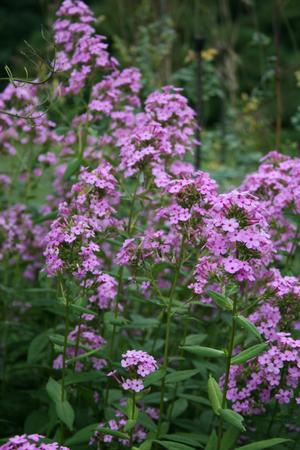Printed at http://www.newmoonnursery.com/index.cfm/
Phlox maculata
Wild sweet William, meadow phlox
Native to North America
FIRST IMPRESSIONS: Phlox maculata is an upright perennial wildflower with bright green lance shaped leathery leaves. In summer, the glossy foliage is topped by large conical clusters of fragrant pinkish-purple flowers. Meadow phlox forms colonies in low open areas with moisture and good drainage. Plants also thrive in sunny gardens with average to moist well drained soil.
HABITAT & HARDINESS: Phlox maculata occurs in some of the eastern Canadian provinces and from Maine to Georgia west to Minnesota and Mississippi. This species has a scattered distribution and is not common in the wild.
Phlox maculata is indigenous to low woods, wet prairies, moist meadows fens, wooded roadsides, river banks and abandoned fields. In prairie situations, plants generally occur in the edges near woodlands or water rather than in open prairie.
Plants are hardy from USDA Zones 4-8.
PLANT DESCRIPTION: Phlox maculata is an erect perennial with strong slender unbranched stems. The stems are smooth, green and spotted or streaked with purple.
Leaves are lance shaped with smooth or finely toothed edges and sharply pointed tips. The glossy blades are 2-4” long and less than 1” wide. They are rounded at the base and have no petioles.
The leaves are opposite and arranged in widely spaced pairs along the stems.
The stems terminate in showy elongated flower panicles. The entire panicle is 3-8” long and narrower than it is wide. The fragrant florets have 5 flat obovate bright pink, rosy-lavender or occasionally white petals. The lower part of the corolla is fused into a narrow tube.
Blooming occurs in summer for 4-8 weeks. Small inconspicuous oval capsules follow.
Plants grow 2-3’ tall with a 1-2’ spread and originate from a taproot and short rhizomes.
CULTURAL & MAINTENANCE NEEDS: Phlox maculata flourishes in sunny sites with moist rich soil. Plants tolerate light shade, silty or sandy loams, alkaline pH and heat.
This phlox is very resistant to powdery mildew but the resistance is enhanced if plants are provided with good air circulation and overhead irrigation is avoided. In hot dry sites plants are sometimes plagued by spider mites.
Plants are intolerant of drought and may need irrigation during extended dry periods. Mulching is beneficial to conserve water and keep roots cool.
Deadheading spent flowers can prolong the season of bloom and prevent unwanted seedlings.
LANDSCAPE USES: This species is a good Accent for a Wildlife Garden or Perennial Border. Plants are also used as Butterfly Nectar Plants or as part of a Grouping or Mass Planting. Phlox maculata has Showy Blooms and is appropriate for Cottage Gardens, Low Maintenance Plantings and Perennial Borders.
COMPANION & UNDERSTUDY PLANTS: Try pairing Phlox maculata with Amsonia illustris, Carex vulpinoidea, Helianthus decapetalus, Lobelia siphilitica, Luzula acuminata, Penstemon digitalis or Panicum virgatum ‘Northwind’.
Phlox paniculata has similar appearance and culture and could be substituted in some situations.
TRIVIA: Phlox maculata flowers provide nectar for butterflies, skippers, moths and hummingbirds. Mammalian herbivores like groundhogs, rabbits and deer nibble the foliage.
Phlox maculata has unique purple spotted stems and elongated flower panicles that help distinguish it from other Phlox spp.
The specific epithet maculata comes from the Latin word for “spotted” due to the purple speckled stems. The species is sometimes called spotted phlox or speckled phlox.
Height:
2-3 ftSpread:
1-2 ftSpacing:
18 inUSDA Hardiness Zone:
4-8Bloom Color:
Pink, VioletPhlox maculata Characteristics
Attracts Wildlife
- Pollinators
- Hummingbirds
- Butterflies
Attributes
- Dried Flower
- Bog
- Naturalizing
- Rain Garden
- Fragrant
- East-Coast Native
Exposure
- Full Sun to Partial Shade
Flowering Months
- October
- September
- August
Foliage Color
- Green
Juglans nigra Tolerance (Black Walnut)
- Yes
Soil Moisture Preference
- Well-Drained
- Moist
Interesting Notes:
For more information on this plant, visit the USDA PLANTS Database: http://plants.usda.gov/java/profile?symbol=PHMA4

